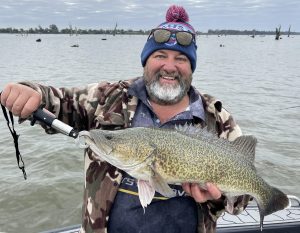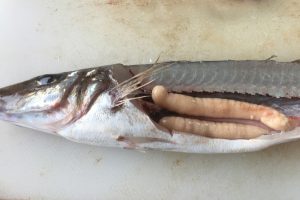
Kevin Wild of the Maryborough Angling Club with one of the Murray Cod he caught and released during round 2 of the Teams Fishing Australia event held on Lake Mulwala over the weekend (Picture: Maryborough Angling Club).
Corio Bay/Bellarine Peninsula
With a break in the weather and calm seas early last week, Garry Ridgeway headed out off Clifton Springs after the whiting, and anchored up in just over 4 metres of water by 1.30 pm, just out from the long jetty ruins, found perhaps, more action than he’d bargained for.
By 4.30 pm he’d caught his bag limit of whiting, including several over 40 cm, along with five squid, one nudging 2 kg, a rewarding session certainly, but interrupted by an uninvited dinner guest; a bronze whaler of possibly 2.5 metres that had Garry hurriedly retrieving his lines and berley bag.
Considering the water temperature in the bay is only about 16.5 Celsius, I asked if he thought it might have been a colder water species. But no, he’s seen enough bronzies to know.
Fortunately, after making several passes below, beside and around his boat – but with nothing to hold its interest – it eventually moved on.
On Thursday, Andrew Johnson and Dennis O’Brien started well off Curlewis, catching fifteen whiting in quick succession before all went quiet. But, after a series of moves, they found another good patch in 6 metres of water off Leopold, finishing off their respective bag limits of fish to 43 cm.
And that’s normal with the excellent state of our whiting fishery, but finding one of their larger fish, at 41 cm in full roe was a surprise, given the present understanding that they customarily spawn offshore rather than inside the bay.
Heading out from Portarlington’s Fairfax Street ramp on Thursday afternoon, Simon Werner fished on the drift just off Steeles Rocks where squid were initially hard to come by, but – after putting in a three-hour session – he finished up with his bag limit of ten that included some big ones.
And indeed, Rod Ludlow of Beachlea Boat Hire at Indented Head reports that squid have been the main capture of late.
Off the Beach
Arriving at Jan Juc early on Thursday morning, Ray Millman rigged up with his ever-dependable 42-gram Savage Sea Missile in front of Life Saving Club building where he’d previously been successful on the salmon, and with a rising tide, he was hopeful.
Initially, there wasn’t much doing, but after several casts he captured a salmon, the first of a dozen or so as it turned out, the biggest around the kilogram mark.

A King George Whiting in full Roe, an unusual catch from Corio Bay (Picture: Andrew Johnson).
Freshwater
Over the weekend, Maryborough Angling Club Members Kevin Wild, Stephen Eales and Rob Baxter – under the “Goldfields Campers” banner – fished round 2 of the “Teams Fishing Australia” catch, photograph and release series of events, this time on Lake Mulwala.
While they caught good samples of cod and yellowbelly they weren’t in the winner’s circle, which required the highest total measurement from 5 of each of those species.
That honour went to Team 9, of Jack Hocking, Peter Howell, and Brad Murray – under the “Hogans Heroes” banner – who picked up a cheque for $10,000 for their catch that included their biggest cod at 114.5 cm and their biggest yellowbelly at 59 cm.
With redfin still on the bite at Lake Lonsdale up past Stawell, Kevin reports that Maryborough Angling Club members, including Ken Hinks, have continued to make the 100 plus kilometer journey, and continue to be rewarded with some very large redfin.
While the reddies would probably respond to a variety of presentations, trolling various lures, including Beetlespins, and jigging with soft plastics, has continued to produce redfin, some well over the 45 cm mark.
Keith asks:
Geoff, an article I read suggested the use of a running sinker for snapper: What is a running sinker?
Keith, rigging a running sinker rig is initiated by first threading your line through a small to medium sized ball sinker before tying on your hook, or alternatively, a short leader – preferably about twice the strength of your main line – with a hook at one end and a swivel or ring at the other.
This rig enables any fish picking up the bait to pull line freely through the sinker rather than dragging the sinker along behind, and maybe spooking it, as might be the case if the sinker were fixed to the line.
